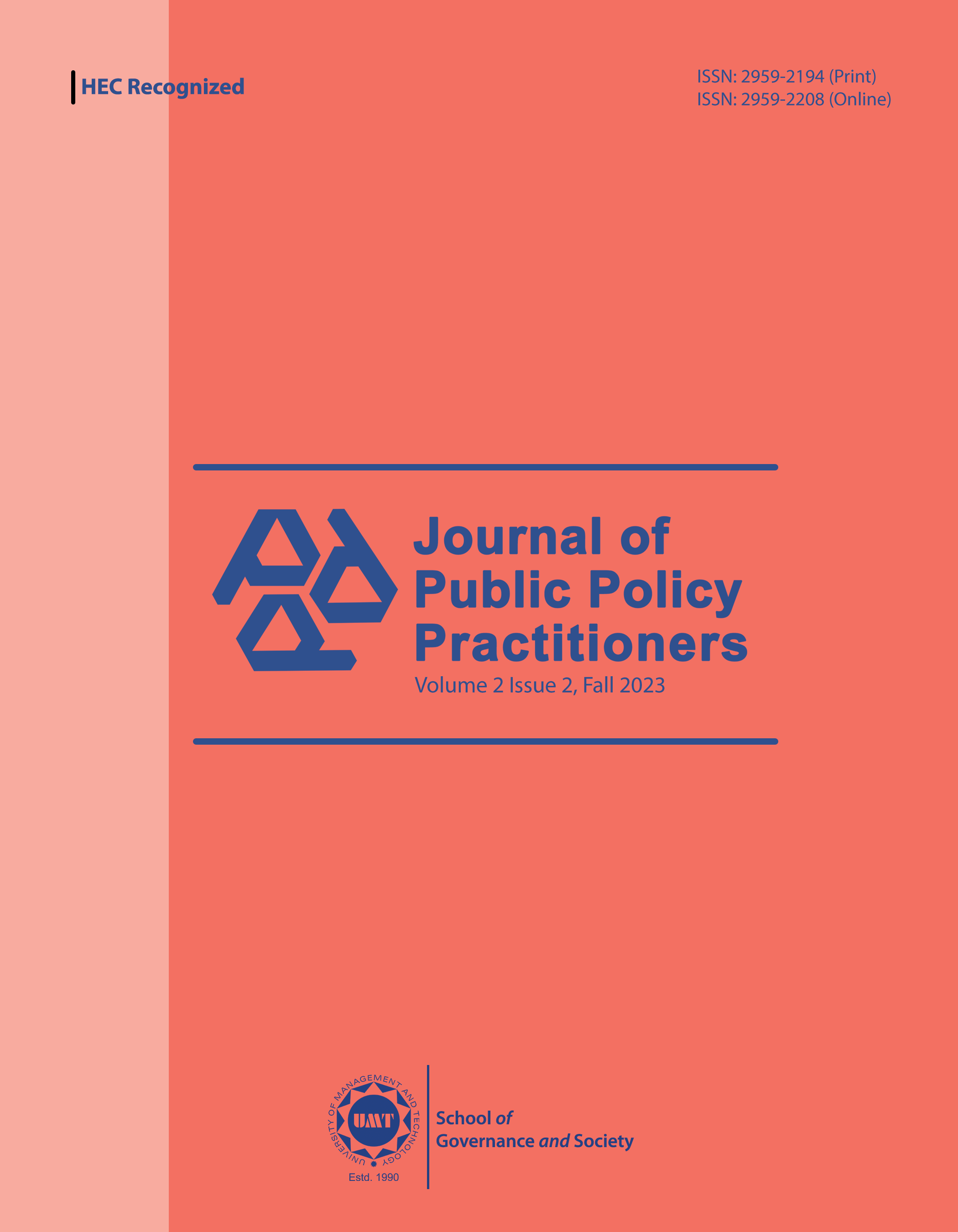Violence against Women: An Analysis of the Infirmed Legal System of Pakistan
Abstract
 Abstract Views: 0
Abstract Views: 0
In Pakistan, a woman's life is governed by the rigid norms of her extended family, faith, and tribal community. This paper aims to investigate the philosophy behind gender-based violence, particularly the violence against women and its related customary practices in different areas in Pakistan, in the backdrop of the infirmed legal system of the country. The authors employ descriptive method to scientifically address the concerned issue. The theory of social change, which broadly focuses on the problem, is additionally significant to probe the violence against women in Pakistan. Throughout the country, women are subjected to a wide range of detrimental customs, including forced marriages, religious conversions, and the exchange of women in marriage without their consent. This study looks into why gender-based violence persists in Pakistan, despite the establishment of the state in the name of Islam, a religion that emphasizes women’s equality and respect in the society. By examining all relevant aspects, the study concludes that customary laws are dominant over state legislation in protecting women from violence. The study determines that Pakistan's legal system is flawed, with significant gaps that must be filled by well-structured legislation to ensure women's safety from abuse.
Downloads
References
Action Aid, Gender and Development Network. (2020). A theory of change for tackling violence against women and girls. https://www.womenindisplacement.org/sites/g/files/tmzbdl1471/files/2020-10/theory_of_change_on_vawg.pdf
Ashfaq, M. (2013, January 8). KP assembly bans forced marriage under Ghag. Dawn. https://www.dawn.com/news/777316/kp-assembly-bans-forced-marriage-under-ghag
Bhattacharya, S. (2020). Violence on women: An 'acceptable' assertion in Pakistan . World Affairs Summer, 24(2), 142–158. https://www.jstor.org/stable/48629030
Critelli, F. M., & Willett, J. (2013). Struggle and hope: Challenging gender violence in Pakistan. Critical Sociology, 39(2), 201–221. https://doi.org/10.1177/0896920512438780
Davies, L. (2008). Gender, education, extremism and security. Compare, 38(5), 611–625. https://doi.org/10.1080/03057920802351432
Eurasian Times Desk. (2020, January 28). Hindu girl abducted from wedding in Pakistan; Converted & married-off. Eurasian Times Desk. https://eurasiantimes.com/hindu-girl-abducted-from-wedding-in-pakistan-converted-married-off/
French. S. G., Teays, W., & Purdy, L. M. (1998). Violence against Women: Philosophical perspectives. Cornell University Press.
Friday Times. (2023, July 11). Punjab records 10,365 cases of violence against women in just four months. https://thefridaytimes.com/11-Jul-2023
Human Rights Watch. (2006, September 6). Pakistan: Proposed reforms to hudood laws fall short. Human Rights Watch. https://www.hrw.org/news/2006/09/06/pakistan-proposed-reforms-hudood-laws-fall-short
Human Rights Watch. (n.d.). Pakistan events of 2022. Human Rights Watch. https://www.hrw.org/world-report/2023/country-chapters/pakistan.
Imran, R., & Munir, I. (2018). Defying marginalization: Emergence of women’s organizations and the resistance movement in Pakistan: A historical overview. Journal of International Women’s Studies, 19(6), Article e9.
Iqbal, M. (2022, December 8). Forced marriages – Reasons and circumstances. Daily Times. https://dailytimes.com.pk/1037140/forced-marriages-reasons-and-circumstances/
Jafar, A. (2007). Engaging fundamentalism: The case of women's NGOs in Pakistan. Social Problems, 54(3), 256–273.
Kaur, R., & Garg, S. (2008). Addressing domestic violence against women: An unfinished agenda. Indian Journal of Community Medicine, 33(2), 73–76. https://doi.org/10.4103/0970-0218.40871
Krantz. G., & Garcia-Moreno, C. (2005). Violence against women. Journal of Epidemiology Community Health, 59(10), 818–21. https://doi.org/10.1136/jech.2004.022756
Nasrullah, M. M. (2009). Newspaper reports: A source of surveillance for burns among women in Pakistan. Journal of Public Health, 32(2), 245–249. https://doi.org/10.1093/pubmed/fdp102
Naveed, B. (2019). Violence against women in Pakistan. Human Rights Asia. http://www.humanrights.asia/wp-content/uploads/2019/03/Violence-against-women-in-Pakistan.pdf
Pakistan-Horizon. (2020, March 17). Hegemonic masculinity and its effects: A social stigma. https://pakistanhorizon.wordpress.com/2020/ 03/17/hegemonic-masculinity-and-its-effects-a-social-stigma/
Patel, S., & Gadit, A. M. (2008). Karo-Kari: A form of honour killing in Pakistan. Transcultural Psychiatry, 45(4), 683–694. https://doi.org/10.1177/1363461508100790
Perveen, A. (2016). The constitution of Pakistan (1973) and women rights: An interpretation. Pakistan Journal of Gender Studies, 13(1), 37–52.
Sajid, I. A., Khan, N. A., & Farid, S. (2010). Violence against women in Pakistan: Constraints in data collection. Pakistan Journal of Criminology, 2(2), 93–110.
Sarfraz, A., Sarfraz, Z., Sarfraz, M., & Qarnain, Z. (2022). Gender-based violence in Pakistan and public health measures: A call to action. Bulletin of the World Health Organization, 100(7), 462–464. https://doi.org/10.2471/BLT.21.287188
Siddique, A. (2012, December 9 ). 'Ghagh': The Pashtun custom of men forcing marriage proposals on women. The Atlantic. https://www. theatlantic.com/international/archive/2012/12/ghagh-the-pashtun-custom-of-men-forcing-marriage-proposals-on-women/266059/.
Stamarski, C. S., & Hing, L. S. S. (2015). Gender inequalities in the workplace: The effects of organizational structures, processes, practices, and decision makers' sexism. Frontiers in Psychology, 6, Article e1400. https://doi.org/10.3389/fpsyg.2015.01400
Tahir, R. (2022, November 20). Acid violence. The News International. https://www.thenews.com.pk/print/1011757-acid-violence
Tanoli, S. (2022, August 7). Where Pakistan's domestic violence laws fails. Tribune. https://tribune.com.pk/story/2369842/where-pakistans-domestic-violence-law-fails
The Elders. (2015, April 23). Women’s rights in Pakistan: Failed by a culture of intolerance and impunity. https://theelders.org/news/women-s-rights-pakistan-failed-culture-intolerance-and-impunity
The World Bank. (2019, September 25). Gender-Based violence (Violence against women and girls). https://www.worldbank.org/en/topic/socialsustainability/brief/violence-against-women-and-girls
United Nations Human Rights. (2014). Women's rights are human rights. https://www.ohchr.org/sites/default/files/Documents/Events/WHRD/WomenRightsAreHR.pdf
Weiss, A. M. (2012). Moving forward with the legal empowerment of women in Pakistan. United States Institute of Peace. https://www.usip.org/sites/default/files/SR305.pdf
Copyright (c) 2023 Syed Sibtain Hussain Shah, Marriyam Siddique

This work is licensed under a Creative Commons Attribution 4.0 International License.







